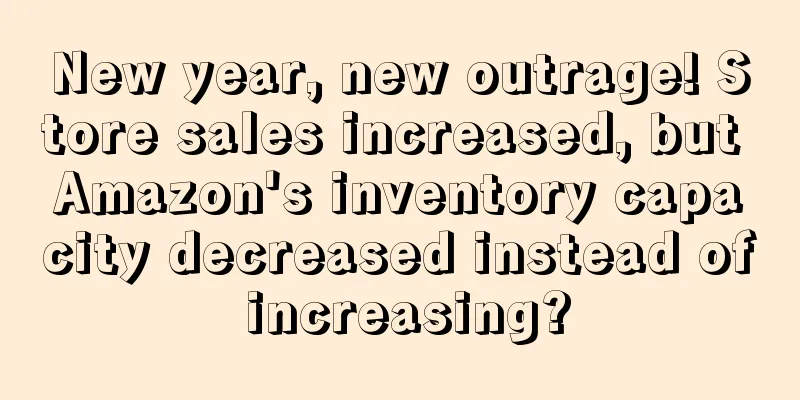New year, new outrage! Store sales increased, but Amazon's inventory capacity decreased instead of increasing?

|
Things are unpredictable, and one of the most uncertain issues for Amazon sellers is stocking up. Therefore, there are often two extreme situations: one is that the goods cannot be cleared, and the other is that the inventory is frequently in short supply. Many people are also more touched by the saying "In the post-epidemic era, whoever has inventory will win the world of Amazon!" At the same time, Amazon FBA has encountered a series of problems such as reduced storage capacity, lost shipments, and rising costs, which have added many obstacles to sellers' path to overseas expansion. Amazon's inventory capacity rules are hard to find! Sales volume increased, but inventory capacity decreased instead of increasing? Amazon is unpredictable and seems to have already determined its nature. This characteristic is reflected in many aspects of Amazon FBA. Recently, some sellers are puzzled by the fact that Amazon's inventory sales have increased, but the storage capacity has decreased instead of increased . In this regard, one seller can only helplessly say: "Amazon's storage capacity changes mainly depend on luck. There is no regularity in the storage capacity." In addition to this phenomenon, a seller complained on the forum a few days ago that his store performance has increased, but the inventory capacity has also decreased . According to him, his store's inventory performance is 705, and the backend performance is 236. Because of the epidemic, he has not managed the store for a period of time. When he logged in again, he found that Amazon prompted that the shipment quantity exceeded the shipment quantity. The current standard size inventory has been exaggerated to 1,000, and it cannot be shipped. Image source: Shared by the seller of Zhiwubuyan I believe everyone is clenching their fists about the drastic cuts in storage capacity. Some sellers even said, "Recently, storage capacity has been cut every Monday. I am convinced. I have sold less than the cuts . For those who were ready to ship before the New Year, now they can only consider overseas warehouses." Many sellers complained that they had encountered the same problem. Seller A: I was able to send 2,000 yesterday, but I found out in the morning that I owed more than 10,000! Seller B: IPI score is 900, but the storage capacity is still reduced from 30,000 to 3,000. Who can I complain to? Seller C: In the past two or three months, it has been reduced from 15,000 to 3,500... I am so annoyed... Sellers are very confused about this matter. Is it because the proportion of redundant inventory is too high, or is it a bug in Amazon? What is the law behind this? A seller consulted customer service and got the reply that in this case, the goods need to be sold, that is, the turnover rate needs to be increased . If the turnover rate is low, the number of shipments will be reduced. Therefore, some sellers frankly said that if the turnover rate is increased, the inventory capacity will basically return in one or two weeks. This also makes people speculate: Amazon's purpose is to want sellers to use their satellite warehouses and AGL logistics. In this regard, sellers can only sigh helplessly: the storage capacity is reduced, the number of workers is reduced, the profit is reduced, and the number of goods they want to ship out every week is increasing! Refuse compensation? Amazon loses shipments, making it difficult for sellers to claim compensation! If it is true as the sellers speculate that Amazon's goal is to get sellers to use their satellite warehouses and AGL, then Amazon's knife for cutting leeks is indeed quite fierce and indeed a bit rogue. Sellers who have been doing business on Amazon for a long time will find that Amazon is merciless when it comes to taking advantage of sellers. A seller complained about Amazon on a forum, and he described his experience of being cheated by Amazon:
Image source: Know everything In this regard, he was indignant and said: "Is there any way to sanction Amazon, this group of cannibals? Will it be useful to ask American lawyers to sue? Is it possible to win the lawsuit against Amazon? " As the dealer, Amazon can formulate the entire operating rules, but the third-party seller group has a lot of people in the group's mentality of being the fish on the chopping board. Faced with Amazon's behavior of losing shipments but not paying compensation, the sellers are of course not convinced. If a shipment to Amazon is lost, there are actually key points to claim compensation . Some sellers have summarized the following: First, the timing is very important. It is understood that for goods lost or damaged during Amazon delivery, claims must be made within the validity period after the exact date when the shipment arrives at the Amazon operation center or a third-party location operated on behalf of Amazon. Second, there are three ways to claim for shipments: 1. Free DIY claim Sellers need to regularly check the progress of shipment processing, organize shipment data, prepare claim letters, and then file a separate claim case with Amazon. 2. Use professional FBA claim tools Such tools save time and trouble than making claims on your own, but are more suitable for operators and operators with experience in claims. Currently, GETIDA and RefundLabs are two tools commonly used by FBA sellers. 3. Entrust a third-party service agency This method is suitable for sellers who are new to claims or have large claims and complicated situations. After a successful claim, they need to provide a certain commission to the service provider. FBA fees in 2023 will be even more "hot"! Sellers are turning to these platforms... In addition to the difficulty in finding the regularity of Amazon's inventory capacity and the difficulty for sellers to claim compensation, Amazon's behavior of shifting costs to sellers has also been criticized from all sides. According to foreign media PracticalEcommerce, Amazon has significantly increased fulfillment fees in the past three years, passing on its own increased costs to sellers. Data from e-commerce intelligence company Marketplace Pulse shows that Amazon has increased delivery fees by more than 30% since 2020. In the past 2022, Amazon has increased FBA fees several times, and has also increased fees such as peak season logistics fees and fuel surcharges. Amazon has already put its price increase plan on the agenda for 2023. Warehouse storage fees, which will take effect on January 17 and April 2023, will increase in the following aspects:
For many Amazon sellers, price increases are inevitable. Therefore, facing the high FBA logistics costs, 99% of sellers who only sell on Amazon said in interviews that they plan to diversify in 2023 , including eBay, Walmart, Newegg and other platforms. Image source: PracticalEcommerce As cross-border e-commerce sellers, we have to admit that Amazon's position in the global e-commerce industry is a huge success, and sellers are an important part of it. As the sellers mentioned above, diversified sales channels can be opened in 2023. Although Amazon will undoubtedly retain its influence in the field of e-commerce, sellers should not rely solely on Amazon. The choice is also in the hands of sellers! |
<<: Cross-border people show off their annual leave, some companies give 23 days!
>>: New track continues to surprise! Amazon big brand won the B round of financing
Recommend
Going public against the trend, Shenzhen Amazon Energy Storage sells well and its A-share IPO is accepted!
Amazon’s iron-blooded ban on accounts over the pa...
What is Dingtong International Logistics? Dingtong International Logistics Review, Features
Shenzhen Dingtong International Freight Forwarding...
Beware! US human rights organizations turn their attention to Xinjiang red dates
Recently, American human rights organizations hav...
Walmart expects back-to-school revenue to rise
According to data released by Walmart, sales of c...
AliExpress Double 11 Global Sales Started, Cainiao's 16 Preferred Warehouses Delivered "Global 5-Day Delivery" Packages
At 4 pm on November 11, AliExpress’s overseas Dou...
Footwear product infringement cases frequently occur, Guangzhou Customs seized 12,000 "Mickey" shoe buckles
According to a report from the General Administra...
What is Mida Freight? Mida Freight Review, Features
Shenzhen Mida Freight Forwarding Co., Ltd. is comm...
What is Hong Kong Tong Overseas Warehouse? Hong Kong Tong Overseas Warehouse Review, Features
Gangtong Overseas Warehouse (gangtong-sc) [formerl...
Spotlight's monthly active users have exceeded 100 million. How far is it from defeating TikTok?
Snapchat is a "disappearing" social sof...
Entering the $33 billion resale market, Rent the Runway undergoes major changes
Rent the Runway is expanding into resale, a major...
Online shopping to account for 51% of global sales post-pandemic
Foreign media reported that after the pandemic, o...
Cainiao and Guizhou Xijiu sign strategic agreement to create a new benchmark for "white wine going global"
On December 21, 2023, Cainiao Group and Guizhou X...
What is 3YData? 3YData Review, Features
3YData is a highly integrated intelligent deliver...
Amazon is in danger! Some countries have told e-commerce platforms to be responsible for fake reviews
Fake reviews have become a headache for consumers...
Shopee 9.9 Super Shopping Festival concluded with over 45 million items sold in 99 minutes
Leading e-commerce platform Shopee announced the ...









